You might wonder, can I straighten my hair after keratin treatment? It’s a valid question, given the treatment itself can be pricey, and you want to maintain your new hair. Worry not because we have the answers you’re looking for!
In this article, we’ll discuss keratin treatment and whether you can use heat-styling tools like straighteners on your newly treated hair. We’ll also talk about additional ways to care for your hair after a keratin treatment. Keep reading to find out more!
Can I Straighten My Hair Following a Keratin Treatment?
Yes, you can straighten your hair after a keratin treatment. It’s rather important to seal the protein in your hair and keep it straight afterward, particularly during the first few days.
A keratin treatment is a hair-smoothing process that employs keratin and coats the strands of your hair. That strengthens the hair shaft, helps reduce frizz, and makes the hair more manageable.

After getting a keratin treatment, it’s best to keep your hair straight as possible in the following days. To ensure your keratin-treated hair lasts longer, follow below recommendations.
- Do not shower or wash your hair for the first 72 hours. That allows the keratin to bond properly with your hair.
- Leave your hair down while you’re sleeping. Avoid ponytails, scrunchies, and hair caps, as they can crease your hair.
- Use a silk or satin pillowcase. It reduces the friction between your hair and the pillowcase.
- If your hair gets sweaty, blow dry your hair as soon as you can at a medium setting. Avoid high heat since it can damage your hair.
- If you find any creases in your hair, use a straightener to straighten them out at medium heat.
In addition, using a straightener right after a keratin treatment is beneficial because heat activates keratin. That will help seal the keratin into the hair fibers and keep your hair smooth and frizz-free.
How To Straighten Your Hair After a Keratin Treatment?

For the keratin treatment to achieve the desired effect, keep your hair straight afterward by following these steps.
- Wash your hair with a sodium-sulfate-free shampoo. This will help maintain the keratin treatment.
- Use a blow dryer to dry your hair. Afterward, straighten your hair and create volume with a round brush.
- Divide your hair from the middle into four sections, two in front and two in back. You can use hair clips to hold them in place.
- Use a heat protectant spray and let it set.
- Set the iron to the optimal temperature. For fine hair, that typically ranges between 350-375 F whereas more coarse or thick hair can handle up to 400-450 F.
- Start by working on the back sections first and iron them from top to bottom in one motion. Do this until there are no more creases left.
It’s best to use a straightener with ceramic plates instead of metal plates. Ceramic plates reduce the amount of heat damage to your hair. They also make your hair shinier and less frizzy than metal versions.
When you straighten your hair, keep the heat low or medium. High heat can be harmful to your locks as it could cause breakage and strip away keratin proteins from your strands.
Summary
You definitely can straighten your hair following a keratin treatment. It’s even beneficial for your hair as the heat activates and seals the keratin, making it smoother and less frizzy. But make sure you set the heat on low/medium setting and use a thermal protection spray before straightening out creases in the hair.
For the first three days after the treatment, you must maintain your hair carefully. The most important thing to do is not wash your hair for these three days. Additionally, use a silk pillowcase while sleeping and let your hair down as much as you can.
FAQs
Here are the most common questions regarding if you can straighten your hair after keratin treatment.
Use sulfate-free shampoos and conditioners that are designed explicitly for keratin-treated hair. Avoid using blow dryers and straighteners on high heat since they can strip away the treatment and cause frizziness.
A keratin treatment can last up to a few weeks to six months. It all depends on your hair care routine, as washing your hair daily and constantly moisturizing it will mean the treatment is likely to be short-lived.
